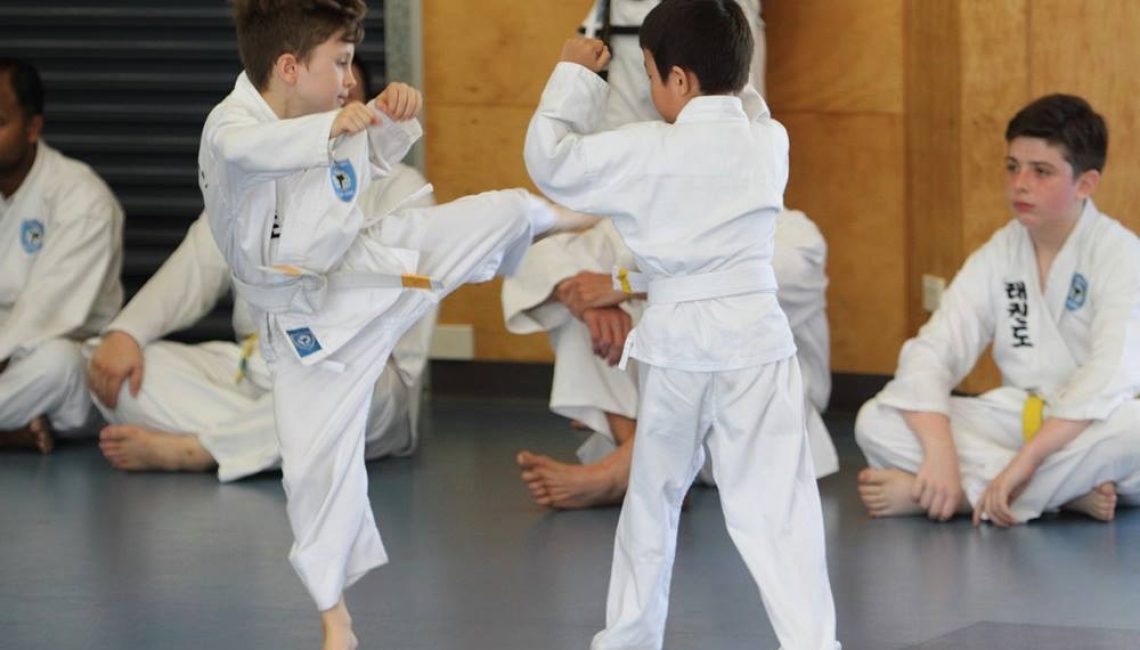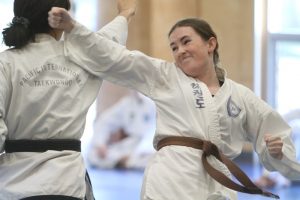Self-Defence (Hosin Sul): How to release from a grab (Jappyosul Tae): While standing: When the belt is being grabbed
“Releasing is performed in three different ways: either by a direct attack to a vulnerable or vital spot, breaking the joint of the attacking hand or arm, or by a logical releasing motion which is usually accompanied by a counter attack.” – Gen. Choi Hong Hi (Vol.5. p.278)
“The defender must know how to make use of his or her opponent’s momentum and force, while utilizing his or her dynamic and reflexive actions against momentarily undefended target.” – Gen. Choi Hong Hi (Vol.5. p.278)
While standing: When the belt is being grabbed
X (attacker), Y (defender). The roles of X and Y can be reversed so that both practitioners can practice all movements.
Method 1
X: From front of Y, with the right hand grab the belt of Y
Y: With both hands grab the right hand of X
Y: Twist to the left, while with the right thumb press the thenar of X’s right hand
Y: Twist to the right, while with both hands twisting the arm of X. X will bend down and the hold of X on the belt will be released.
Note: Thenar relates to the rounded fleshy part of the hand at the base of the thumb on the palm of the hand (the ball of the thumb).
Method 2
X: From front of Y, with the right hand grab the belt of Y
Y: Place the right arm under the right elbow of X, and with the left hand hold the right hand.
Y: Move both hands upwards, while pressing the right elbow of X upwards. The hold of X on the belt will be released.
Method 2.1
X: From front of Y, with the right hand grab the belt of Y
Y: Place the right arm under the right elbow of X, and with the left hand hold the right hand.
Y: Move both hands upwards, while pressing the right elbow of X upwards. The hold of X on the belt should be released, but if the hold is strong then it may not release.
Y: Move the left foot forward, while with the left hand hold the back of shoulder of the right hand of Y.
Y: With the right arm press the right elbow of X upwards, while with the left hand press X’s shoulder downwards. X will bend down and the belt will be released.
Method 3
X: From front of Y, with the right hand grab the belt of Y
Y: With the right middle knuckle fist, perform a high vertical punch to the philtrum of X. The hold of X on the belt will be released.
Method 3.1
X: From front of Y, with the right hand grab the belt of Y
Y: With the right middle knuckle fist, perform a high vertical punch to the philtrum of X. The hold of X on the belt should be released, but if the hold is strong then it may not release.
Y: Move the right foot forward and with a twin knife-hand, perform a high inward strike to both sides of the neck of X. The hold of X on the belt will be released.
Method 4
X: From front of Y, with the right hand grab the belt of Y
Y: With the left hand grab the thumb of X’s right hand, and place the right hand under X’s elbow
Y: Bend X’s thumb by pulling it backwards, while pushing X’s elbow upwards. The hold of X on the belt will be released.
Method 4.1
X: From front of Y, with the right hand grab the belt of Y
Y: With the left hand grab the thumb of X’s right hand, and place the right hand under X’s elbow
Y: Bend X’s thumb by pulling it backwards, while pushing X’s elbow upwards. The hold of X on the belt should be released; however, if the hold is strong then it may not release.
Y: Move the left foot forward and twist clockwise, while bending X’s thumb backwards and elbow upwards. The hold of X on the belt will be released. Further bending of X’s thumb may break X’s thumb.
Note: The position of legs and arms will be reversed if X grabs the belt with the left hand. Both variations may be practiced. Again, if X holds the belt of Y with palm facing upwards can lead to additional variations. All types of variations may be practiced.
Taekwon-Do is a practical art; hence it can be learnt only from an instructor. Words, diagrams and videos can help only as a reference, and they cannot replace an instructor. Expert practical guidance from an instructor is invaluable.
“Certainly the most important asset any training hall can have is a good instructor. There is no substitute for a well-trained, intelligent, perceptive and patient instructor.” – Gen. Choi Hong Hi (Vol.6, p.17).
REFERENCE:
Choi, H. H. (1985). Encyclopedia of Taekwon-Do (Vols. 1–15). Vienna: International Taekwon-Do Federation.
Also see:
Self-Defence Techniques (Hosin Sul): An Introduction
Need high-quality martial arts gear at reasonable prices?
Pacific Sports (a subsidiary of Pacific International Taekwondo) offers a range of high-quality, functional and affordable Taekwondo, Karate, Jiu Jitsu uniforms, as well as Martial Art and Kickboxing equipment, Kick Boxing Shorts, MMA Rash Guards, MMA Gloves, TKD paddles, Shin Guards, Kick Shield, Instep Pad Guards, Focus Pads, Focus Mitts, TKD shoes and Gel Hand Wraps.
Avail the benefits of discounts, free shipping and clearance sales.
PACIFIC SPORTS
Phone:
+61 415383635
Email:
info@pacific-sports.com
Website:
https://pacific-sports.com




